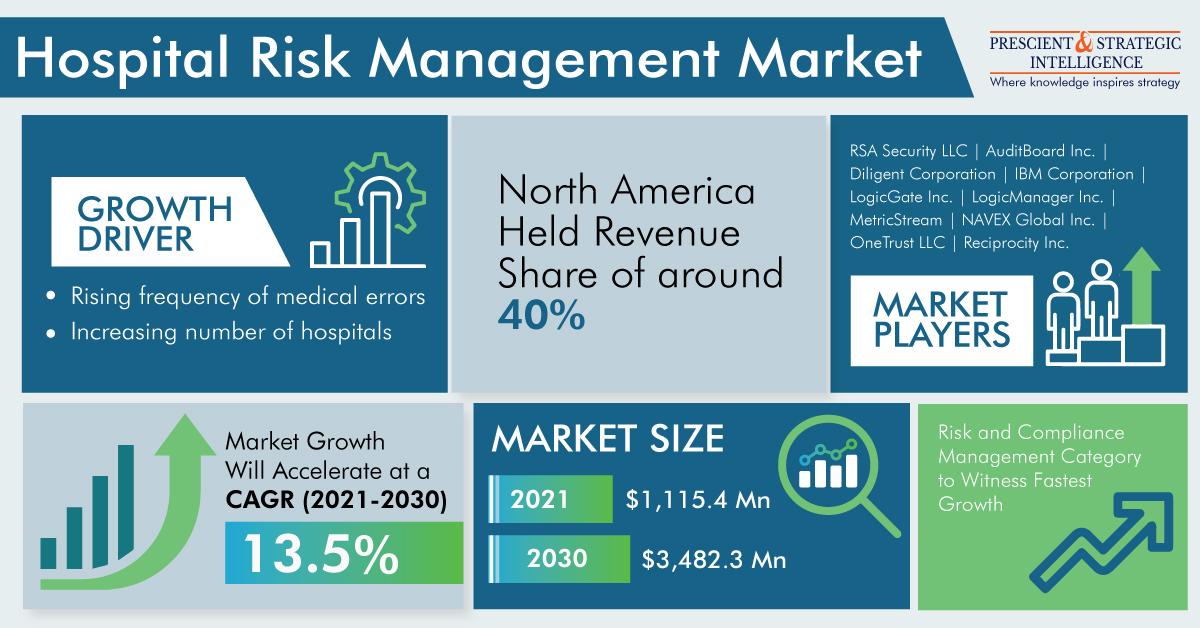Analysis of current procedures and practices, identification of risk factors, and implementation of countermeasures are all parts of risk management. The stakes are even greater in the healthcare industry since risk management might indicate the difference between life and death. Risk management in the hospital may be more crucial than in any other sector in several ways.
Risks in ho include medical misconduct, treatments, defective equipment, and other dangers. To keep patients, secure and safe and to control costs, the health care sector must effectively manage these and other risks. Hospitals, long-term care homes, and other healthcare organizations can reduce the possibility of loss after using risk management measures.
As per the P&S Intelligence, in 2021, the hospital risk management market was worth around $1,115.4 million, and it will generate $3,482.3 million by 2030, growing at a 13.5% CAGR from 2021 to 2030. This will mostly be caused by the increase in medical mistakes and the increasing prevalence of chronic illnesses worldwide.
According to a government agency, the standardized infection ratio related to ventilators increased by 30%, hospital-onset MRSA infections increased by around 15%, and CLABSI frequency increased by 25% in the past. Hospitals are experiencing a sharp rise in the need for risk and compliance management services as a result of the sharp rise in HAIs.
Clouds are well-established and ubiquitous tools nowadays. Every industry has unique implementation requirements, though, of course. The hospitals have led the way in several developments. Cloud computing is the same. The use of cloud computing in hospitals is beneficial in many ways, including streamlining the development and upkeep of telemedicine apps and facilitating the safer and simpler transmission of medical information.
COVID-19 has prompted the broad acceptance of cloud-based hospital risk software solutions to build a robust network among hospitals and collect information on the count of COVID-19 patients and the number of available beds.
Risk Classification for Healthcare System
It makes sense to categorize various risk categories to comprehend the justifications for implementing the risk management process in healthcare. Additionally, it will make it easier to comprehend the extent of the effort required for a hospital to implement ERM.
• Clinical Risks
Clinical hazards result from poor healthcare delivery. Now, the focus in healthcare is on quality. Many organizations use a pay-per-performance approach, which implies that hospitals and doctors are given cash rewards or penalties for achieving certain performance goals.
• Operational Risks
Schedules, prescriptions, the transmission of lab results, billing, and other organizational activities are all part of the healthcare industry. High-quality healthcare cannot be provided if such processes are not efficient.
• Technological Risks
Poor performance of different telemedicine systems, biomedical equipment, EHR software, and solutions that support the administrative processes of the business are all linked to technological threats.
• Financial Risks
Financial risks relate to a healthcare organization's capacity to get and keep access to finance, receive assistance from the government, and carry on business in the face of severe financial penalties.
Hence, all firms must practice risk management, but hospitals are particularly critical since patient lives are at stake. A sound hospital risk management strategy may lower financial, legal, and health risks to patients. Therefore, the demand for hospital risk management is rapidly growing year on year.


